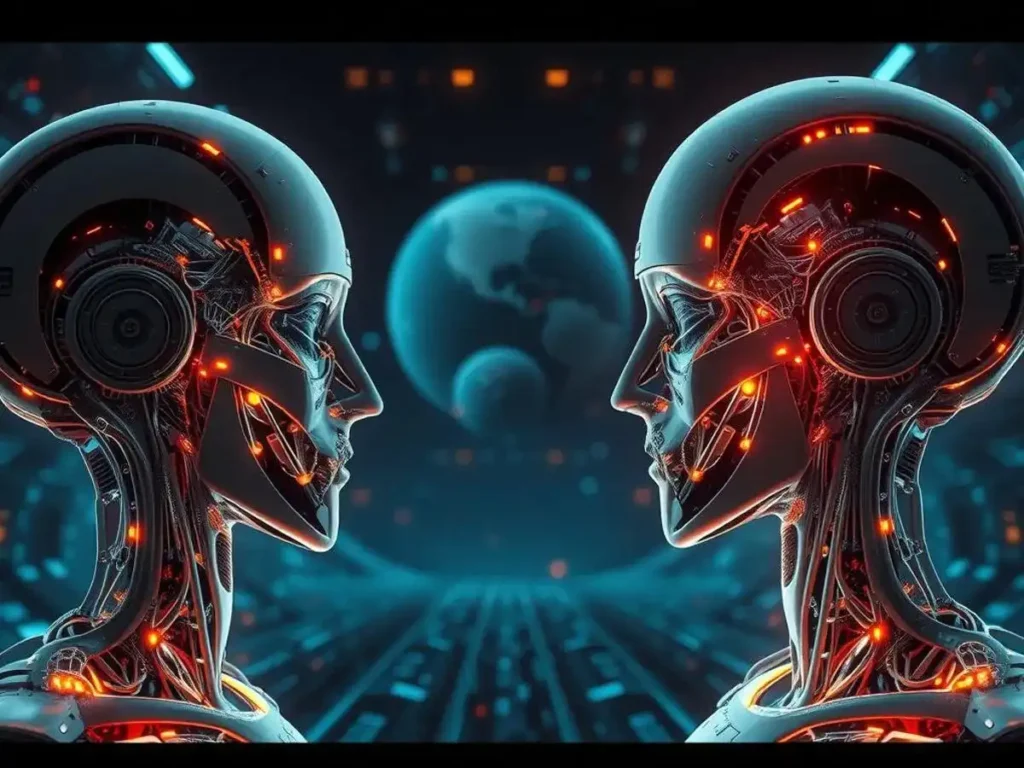Many people get confused when talking about AI agents vs agentic AI. Do these terms mean the same thing, or are they different? We’ll see how each one affects the future of automation and decision-making.

From chatbots helping with customer service to systems controlling smart homes, the difference between AI agents and agentic AI is big. It affects how we use technology every day and the new ideas in industries. Find out why this difference is important for businesses and developers in the AI world.
Introduction to AI Agents and Agentic AI
Artificial intelligence systems have many forms, each for a specific role. This section looks at two main types: AI agents and agentic AI. Both use artificial intelligence but for different reasons.
Defining AI Agents
AI agents do tasks they’re programmed for. Think of Siri or Alexa—these tools do things like set reminders or play music. They act based on what you tell them and their code, not on their own.
Understanding Agentic AI
Agentic AI makes choices on its own, with little human help. For example, self-driving cars change speed and route by themselves, using current data. They learn and adapt thanks to complex algorithms.
| Feature | AI Agents | Agentic AI |
|---|---|---|
| Purpose | Task execution | Self-directed problem-solving |
| Autonomy Level | Low (rule-based) | High (adaptive logic) |
| Learning Capacity | Static unless updated | Continuous learning |
Even though both use artificial intelligence, they work differently. This helps us understand their roles in technology’s future.
Historical Development of Artificial Intelligence
The journey of artificial intelligence started in 1956 at the Dartmouth Conference. Early researchers wanted to make systems that could think like humans.
By the 1980s, expert systems came into being. These systems used set rules to solve specific problems. They helped pave the way for future AI advancements.
In the 1990s, intelligent agents became more common. These programs could do tasks on their own. Projects like SOAR showed how agents could learn from their interactions.
Now, with machine learning and big data, AI has grown even more. Today’s intelligent agents use neural networks and real-time data. They help with everything from virtual assistants to self-driving cars.
This progress shows how far we’ve come. It’s a result of decades of work to make AI more powerful. It’s now a key driver of innovation in many fields.
Technological Foundations: Machine Learning and Natural Language Processing
Modern AI systems depend on two key technologies: machine learning and natural language processing. These areas help AI agents learn, adapt, and talk to us. They are the heart of today’s smart systems, from predicting outcomes to translating languages.
The Role of Machine Learning
Machine learning algorithms help AI make decisions. They look at huge amounts of data to spot patterns and predict what will happen next. There are different types, like supervised learning, which uses labeled data, and unsupervised learning, which finds hidden patterns.
Google uses machine learning to make search better and improve Photos. Reinforcement learning, on the other hand, lets systems learn by trying things and seeing what works.
Advancements in Natural Language Processing
Natural language processing changes how machines understand us. New neural networks and transformer models, like those from OpenAI, help chatbots understand what we mean. Sentiment analysis tools, used by Amazon, can tell how happy or sad we are based on what we write.
Voice assistants like Siri use NLP to understand what we say. This shows how language processing connects us to machines.
Understanding AI agents vs agentic ai
When comparing ai comparison between agents and agentic systems, we see big differences. AI agents work by following set rules, like chatbots answering the same questions. Agentic AI, on the other hand, learns and makes choices on its own, like self-driving cars changing routes.

| Feature | AI Agents | Agentic AI |
|---|---|---|
| Autonomy | Rule-based actions | Self-directed decisions |
| Learning | Limited to training data | Continuous adaptation |
| Scope | Narrow task focus | Dynamic problem-solving |
| Examples | Virtual assistants | Industrial robotics |
Businesses pick AI agents for tasks they know well. Agentic AI is better for complex, changing situations. This AI comparison helps teams choose the right tool for their needs. Whether it’s for steady automation or for solving new problems, there’s a fit.
Applications in Business and Industry
AI agents and agentic AI are changing industries in big ways.
Real-World Use Cases
Retail giants like Amazon use AI agents to improve customer service. They cut response times by 40% in some cases. Agentic AI also helps in healthcare, like at Mayo Clinic, for early disease detection.
Manufacturers like Tesla use agentic AI for quality control. They reduced defects by 25% thanks to it. These examples show how AI solves specific problems in different industries.
Impact on Organizational Efficiency
AI agents help cut costs in business, like in logistics for UPS. They save millions a year by optimizing routes. Process optimization tools in energy companies like Shell predict equipment failures, avoiding downtime.
In finance, AI improves fraud detection by 30%. This protects billions in transactions. These systems keep getting better on their own, without needing humans.
Comparing Intelligent Agents and Agentic AI Models
Traditional intelligent agents use set rules to do tasks. They work best in places where things are predictable. On the other hand, agentic AI models learn on their own and change as they go.

Agentic AI models, like those from OpenAI or Google, focus on being independent. They keep getting better without needing people to help much. Intelligent agents need updates from humans to handle new situations. This makes a big difference in how well they can grow and change.
Intelligent agents are good at doing the same thing over and over. Agentic AI models are better at solving hard problems but need more computer power. For example, chatbots use intelligent agents for simple questions. But agentic AI models could handle more complex tasks, like improving supply chains in real time.
Choosing between these depends on what you want to achieve. Agentic AI models are great for new ideas in fields like health or finance. But if you need something very reliable, like in security, traditional systems might be better. Knowing the differences helps pick the right technology for your business.
The Role of Supervised Learning in AI Development
Supervised learning is key to modern AI systems. It helps algorithms learn from labeled data. This way, machines can predict outcomes, classify data, or spot patterns.
Tech giants like Google and Tesla use it. They improve search algorithms and make autonomous driving systems better.
Overview of Supervised Learning
Supervised learning trains models with data and correct answers. For instance, medical researchers use it to spot diseases in X-ray images. They compare thousands of labeled scans.
The process has three main steps: preparing data, training models, and validating them.
| Algorithm | Use Case | Example |
|---|---|---|
| Linear Regression | Predictive analytics | Stock price forecasting |
| Decision Trees | Classification tasks | Customer churn prediction |
| Neural Networks | Image recognition | Facial recognition systems |
Benefits for AI Systems
Supervised learning makes AI more accurate over time. Companies like OpenAI improve chatbots with user feedback. This method also cuts down errors in fraud detection systems at banks.
However, it needs lots of labeled data. So, data quality is crucial for success.
Autonomous Systems: Benefits and Limitations
Autonomous systems are changing the game in many industries. They do tasks on their own, without needing a human to guide them. This means fewer mistakes in making things and safer work in dangerous places.
For example, Tesla’s autopilot and Amazon’s warehouse robots make things run smoother. They save money and make things more efficient. These systems are great at doing the same thing over and over or when it’s too risky for people.
But, there are still problems to solve. For instance, when self-driving cars have to choose between two bad options, it raises big questions. They need perfect data and can’t always predict what will happen next.
Keeping these systems working right also needs special skills. This can be expensive, making it hard for small businesses to use them.
| Benefits | Limitations |
|---|---|
| 24/7 operation without fatigue | Ethical decision-making dilemmas |
| Improved precision in repetitive tasks | High dependency on data quality |
| Reduces workplace hazards for humans | Potential system failures in unstructured environments |
Healthcare and logistics are starting to use these systems more. However, finding the right balance between new tech and keeping an eye on it is crucial. As tech gets better, solving these issues will help them become more common.
Emerging Trends in Artificial Intelligence and Machine Learning
The AI world is changing fast, thanks to new tech breakthroughs. AI agents and agentic AI are changing how we automate and make decisions. New methods are making AI work better in real life.
Innovative Approaches
Scientists are mixing machine learning with natural language processing for smarter AI. Now, AI can make fake data and learn from it. Here are some big changes:
| Trend | Application |
|---|---|
| Generative AI | Data synthesis for training models |
| Reinforcement Learning | Autonomous decision systems |
| Multi-modal NLP | Unified text, audio, and visual processing |
Future Research Directions
Experts are working on making AI fair and unbiased. Quantum computing might make AI training faster. Also, decentralized AI could make systems more secure.
These changes aim to fix big problems like making AI work better, be clear, and adapt quickly. As agentic AI grows, it will bring big changes to fields like healthcare and finance.
Navigating Challenges in Implementing AI Solutions
Starting AI systems can be tough. Companies face issues like bad data, growing pains, and tech problems. These hurdles can slow things down or make costs go up if not tackled early.

Common Obstacles
Bad data is a big problem. Old algorithms or missing data hurt model accuracy. Also, old IT systems can cause trouble when trying to add new AI tools.
Getting the right people and money is hard, too. Many businesses struggle to train teams and find budgets.
Strategies for Successful Integration
Doing data checks helps make sure AI models get good data. Working with experts in the beginning helps avoid mistakes. Here are some key challenges and how to solve them:
| Obstacle | Action Plan |
|---|---|
| Data fragmentation | Centralize databases using ETL processes |
| Technical debt | Phase upgrades instead of full overhauls |
| Workforce resistance | Provide hands-on training programs |
Using agile methods helps make small, steady improvements. Companies like Walmart and Siemens have grown AI by making small changes. Keeping everyone informed builds trust in new systems. Regular checks help see how things are going and make changes as needed.
Conclusion
AI agents and agentic AI are two main paths in today’s tech world. AI agents follow set rules to do tasks, like chatbots in customer service. On the other hand, agentic AI can change on its own, leading to big leaps in areas like self-driving cars.
Businesses need to pick the right AI for their goals. AI agents are good for routine tasks, while agentic AI is better for solving complex problems.
Machine learning and natural language processing are making these AI types better. Companies using AI agents see their operations get smoother. Agentic AI, on the other hand, brings new ideas to fields like healthcare and manufacturing.
But there are still big challenges, like making sure the data is good and handling ethics. It’s important to plan carefully when using AI.
The future looks bright with smarter AI systems and better decision-making tools. Keeping up with these changes is key for companies. They need to use AI wisely to grow and stay ahead in a fast-changing world.
Table of Contents
FAQ
What are the key differences between AI agents and agentic AI?
AI agents do specific tasks on their own, following set rules. It can change its actions based on different situations.
How does machine learning contribute to the development of AI agents?
Machine learning helps AI agents get better over time. They learn from data, thanks to algorithms that spot patterns. This lets them do more than their initial programming.
What role does natural language processing play in agentic AI?
Natural language processing (NLP) is key for agentic AI. It lets them understand and talk to humans. This is crucial for tasks like customer support, where understanding context is important.
What are some real-world applications of AI agents and agentic AI?
AI agents are used in chatbots for customer service. Agentic AI is in systems like self-driving cars and smart assistants. They make decisions based on data in real time.
What challenges are associated with implementing AI solutions?
Issues include poor data quality and scaling problems. There are also complexities in integrating with current systems. Plus, there are ethical worries about using systems that act on their own.
How does supervised learning fit into AI development?
It makes AI systems more accurate and reliable. This is key for many applications.
What trends are currently shaping the future of artificial intelligence?
Trends include better deep learning and more focus on ethical AI. There’s also a rise in federated learning. These changes are happening in areas like healthcare and finance.
Why is it important to understand the distinctions between AI agents and agentic AI?
Knowing the difference helps companies choose the right AI for their needs. This leads to better AI use and integration in their operations.
READ MORE ABOUT LATEST AI & TECH FROM HERE


For the reason that the admin of this site is working, no uncertainty very quickly it will be renowned, due to its quality contents.
I am truly thankful to the owner of this web site who has shared this fantastic piece of writing at at this place.
Good post! We will be linking to this particularly great post on our site. Keep up the great writing
Great information shared.. really enjoyed reading this post thank you author for sharing this post .. appreciated
Good post! We will be linking to this particularly great post on our site. Keep up the great writing